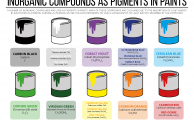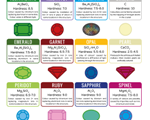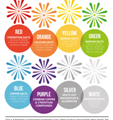
The Chemistry Of Colored Glass
Soda Lime Glass is the most common glass type, making up an estimated 90% of all manufactured glass. Its uses include containers, windows, bottles and drinking glasses. The below percentages are a general composition only; other compounds are also present in smaller amount. Silicon Dioxide (SiO2): 70-74% Calcium Oxide (CaO): 10-14% Sodium Oxide (Na2O): 13-16% Glass […]

Inorganic Compounds As Pigments in Paints [Infographic]
Paints have been manufactured since prehistoric times, but until recently they were highly expensive and thus were mainly used for artwork. It is only since the nineteenth century that houses have commonly been painted. Today paints are used for colouring and protecting many surfaces, including houses, cars, road markings and underground storage vessels. Each of […]

The Colour Chemistry of Gemstones – Precious Stones [Infographic]
A gemstone or gem (also called as precious stone or semi-precious stone, a fine gem, or jewel) is a piece of mineral, which, in cut and polish form, is used to make jewelry or other adornments. The colours of Gemstones – Precious Stones are affected by differences in chemical and atomic structure, leading to the absorption […]

The Chemistry of Fireworks [Infographic]
Colour in fireworks is produced by pyrotechnic ‘stars’, which produce coloured light when ignited. The stars contain five basic ingredients. Metal salts are used to produced colour; a fuel is needed to allow the star to burn; an oxidising chemical provides oxygen for the combustion the fuel; a chlorine-donating compound helps strengthen some colours; and a binding chemical holds […]